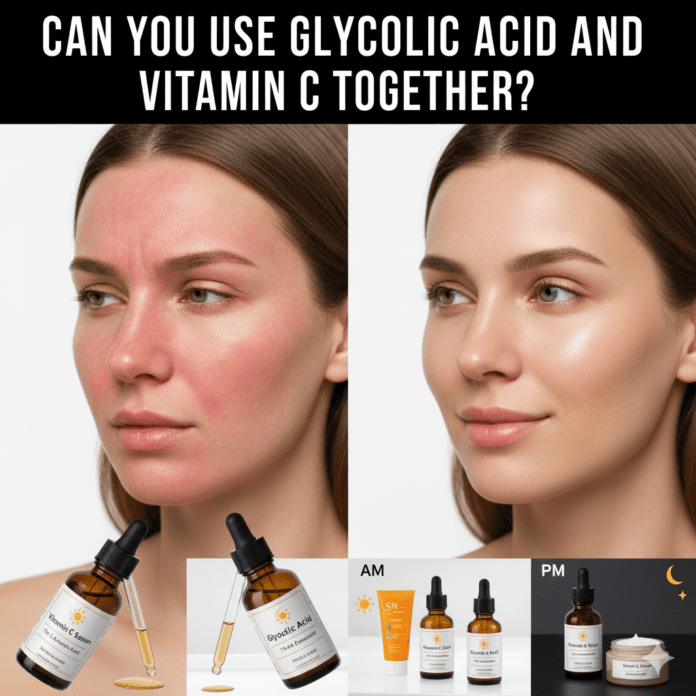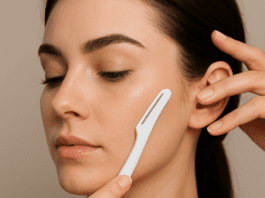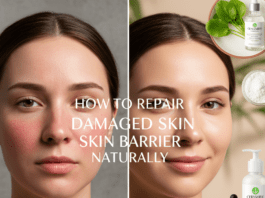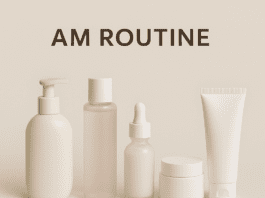In the world of skincare, Vitamin C and Glycolic Acid are A-list celebrities. Vitamin C is the brilliant antioxidant that brightens, protects, and builds collagen. Glycolic Acid is the gold-standard exfoliant that smooths texture, fades dark spots, and reveals a radiant glow. With such impressive résumés, it’s only natural to wonder if you can combine their star power in a single routine.
The question of “can you use glycolic acid and vitamin c together?” is one of the most common—and critical—queries in skincare. Mixing potent active ingredients without understanding their chemistry can lead to irritation, a compromised skin barrier, or simply render your expensive products ineffective.
So, can these two powerhouses share the stage? The answer is nuanced. This definitive guide will break down the science, outline the risks, and give you the safest, most effective strategies for incorporating both ingredients into your routine for maximum results.
Table of Contents
- The Quick Answer: Yes, But It’s All About Strategy
- Understanding the Science: The pH Conflict and Irritation Risk
- Meet the Power Players: A Refresher on Each Ingredient
- The Gold Standard Method: The AM/PM Split Routine
- Advanced Technique: How to Layer in the Same Routine (With Extreme Caution)
- Skincare Cocktails to Avoid: Other Key Ingredient Conflicts
- Frequently Asked Questions (FAQ)
1. The Quick Answer: Yes, But It’s All About Strategy
Let’s get straight to the point. Yes, you can use glycolic acid and vitamin C in your skincare regimen, but it is generally NOT recommended to layer them one right after the other in the same routine.
While they won’t dangerously react, using them back-to-back poses two significant problems: potential for reduced effectiveness and a high risk of skin irritation. The smartest approach involves strategic separation, allowing each ingredient to shine on its own without causing conflict.
2. Understanding the Science: The pH Conflict and Irritation Risk
To understand the “why” behind the caution, we need to look at two key factors.
The Core Issue: The pH Conflict
The pH scale measures how acidic or alkaline a solution is. Skincare ingredients are often formulated to be most stable and effective at a specific pH level.
- Vitamin C (L-Ascorbic Acid): The most potent form of Vitamin C is highly unstable and works best at a very low pH, typically between 3.0 and 3.5.
- Glycolic Acid: As an alpha-hydroxy acid (AHA), it also requires a low pH to be effective, usually below 4.0.
When you layer these two highly acidic products together, you can potentially alter the pH environment on your skin, which may slightly destabilize one or both formulas, leading to them being less effective than when used alone.
The Bigger Risk: Over-Exfoliation and Irritation
This is the primary reason dermatologists and estheticians advise caution.
- Glycolic Acid is a chemical exfoliant that works by dissolving the “glue” holding dead skin cells together.
- Vitamin C, in its acidic form (L-Ascorbic Acid), also has mild exfoliating properties.
Using two potent, low-pH products in succession is a very intense experience for your skin. It can easily overwhelm your skin’s protective barrier, leading to over-exfoliation symptoms like:
- Redness and inflammation
- Stinging or burning sensations
- Peeling and flakiness
- Increased sensitivity to other products
3. Meet the Power Players: A Refresher on Each Ingredient
Let’s quickly review why these ingredients are so coveted.
A Closer Look at Vitamin C (L-Ascorbic Acid)
- What it is: A powerful antioxidant that is essential for skin health.
- Key Benefits of Vitamin C Serum:
- Protects: Neutralizes free radical damage from UV rays and pollution.
- Brightens: Inhibits the enzyme responsible for melanin production, fading dark spots and improving overall skin tone.
- Firms: Plays a crucial role in collagen synthesis, helping to reduce the appearance of fine lines.
- Best Time to Use: In the morning, to act as a shield against daily environmental aggressors.
A Closer Look at Glycolic Acid (An Alpha-Hydroxy Acid)
- What it is: The AHA with the smallest molecule size, allowing it to penetrate the skin deeply and effectively.
- Key Benefits of Glycolic Acid:
- Exfoliates: Sloughs off dull, dead skin cells from the surface.
- Smooths Texture: Minimizes the appearance of bumps, rough patches, and fine lines.
- Boosts Radiance: Reveals the fresher, brighter skin underneath.
- Stimulates Collagen: Deeper penetration can help stimulate collagen production over time.
- Best Time to Use: At night, as it can increase your skin’s sensitivity to the sun.
4. The Gold Standard Method: The AM/PM Split Routine
The safest, most effective, and universally recommended way to use both ingredients is to separate them. This allows each product to work at its optimal pH without interference and dramatically reduces the risk of irritation.
Your Morning (AM) Routine: Vitamin C for Protection
The goal here is to protect your skin.
- Cleanse: Use a gentle cleanser.
- Apply Vitamin C Serum: On dry skin, apply a few drops of your Vitamin C serum. Let it absorb for at least a minute.
- Moisturize: Apply your daily moisturizer to hydrate and lock in the serum.
- Sunscreen: Finish with a broad-spectrum SPF 30 or higher. This is non-negotiable. Vitamin C and sunscreen are a powerhouse protective duo.
Your Evening (PM) Routine: Glycolic Acid for Renewal
The goal here is to treat and regenerate your skin.
- Cleanse: Thoroughly cleanse your skin.
- Apply Glycolic Acid: On dry skin, apply your glycolic acid product (this could be a toner, pad, or serum). Do not use it every night, especially at first. Start with 2-3 times per week.
- Hydrate: (Optional but recommended) Apply a simple, hydrating serum with ingredients like hyaluronic acid or ceramides to soothe the skin.
- Moisturize: Finish with a nourishing moisturizer to support your skin barrier.
5. Advanced Technique: How to Layer in the Same Routine (With Extreme Caution)
For experienced skincare users with very resilient, non-sensitive skin, layering is possible, but it requires precision and patience.
Disclaimer: This method is not recommended for most people. The AM/PM split is superior.
If you must proceed, follow this rule:
- Cleanse your skin and pat it completely dry.
- Apply Vitamin C Serum. It generally has a thinner consistency and needs the lowest pH to be effective.
- WAIT. This is the crucial step. You must wait a full 20-30 minutes. This allows the Vitamin C to fully absorb and for your skin’s pH to begin to normalize.
- Apply Glycolic Acid. After the waiting period, you can apply your glycolic acid product.
- Finish with Moisturizer.
6. Skincare Cocktails to Avoid: Other Key Ingredient Conflicts
Understanding how actives interact is key to a healthy routine. Here are other combinations to be wary of:
- Glycolic Acid + Retinol: Both are powerful exfoliants that stimulate cell turnover. Using them together is a fast track to irritation and a damaged barrier. Solution: Use them on alternate nights.
- Vitamin C + Retinol: Similar to the above. While some advanced formulas combine them, it’s safest for at-home use to separate them. Solution: Vitamin C in the AM, Retinol in the PM.
7. Frequently Asked Questions (FAQ)
Q1: I used glycolic acid and vitamin C together and now my skin is red and stinging. What do I do? A: You’ve likely compromised your skin barrier. Stop using all active ingredients immediately—no acids, no vitamin C, no retinol. Switch to a simple, gentle routine of a milky cleanser, a barrier-repairing moisturizer (with ceramides or cica), and sunscreen for 1-2 weeks until all signs of irritation are gone.
Q2: Can I use a cleanser with glycolic acid, and then apply a vitamin C serum? A: This is generally a lower-risk scenario. A wash-off cleanser has a much shorter contact time with your skin than a leave-on serum. However, if you have sensitive skin, this could still be too much. Monitor your skin closely for any signs of tightness or irritation.
Q3: Does this rule apply to other acids, like lactic or salicylic acid? A: Yes. The same principle applies. It’s best to separate any potent AHA or BHA from your Vitamin C serum to avoid irritation and ensure efficacy.
Conclusion: Work Smarter, Not Harder
While it’s technically possible to use glycolic acid and vitamin C together, the smartest and most effective path to healthy, glowing skin is through strategic separation. By giving each ingredient its own dedicated time to work, you harness its full power without the risk of irritation or diminished results.
Embrace the gold-standard routine: Vitamin C in the morning to protect, and Glycolic Acid at night to renew. This simple switch allows you to enjoy the best of both worlds, ensuring your skin is always supported, radiant, and resilient.




